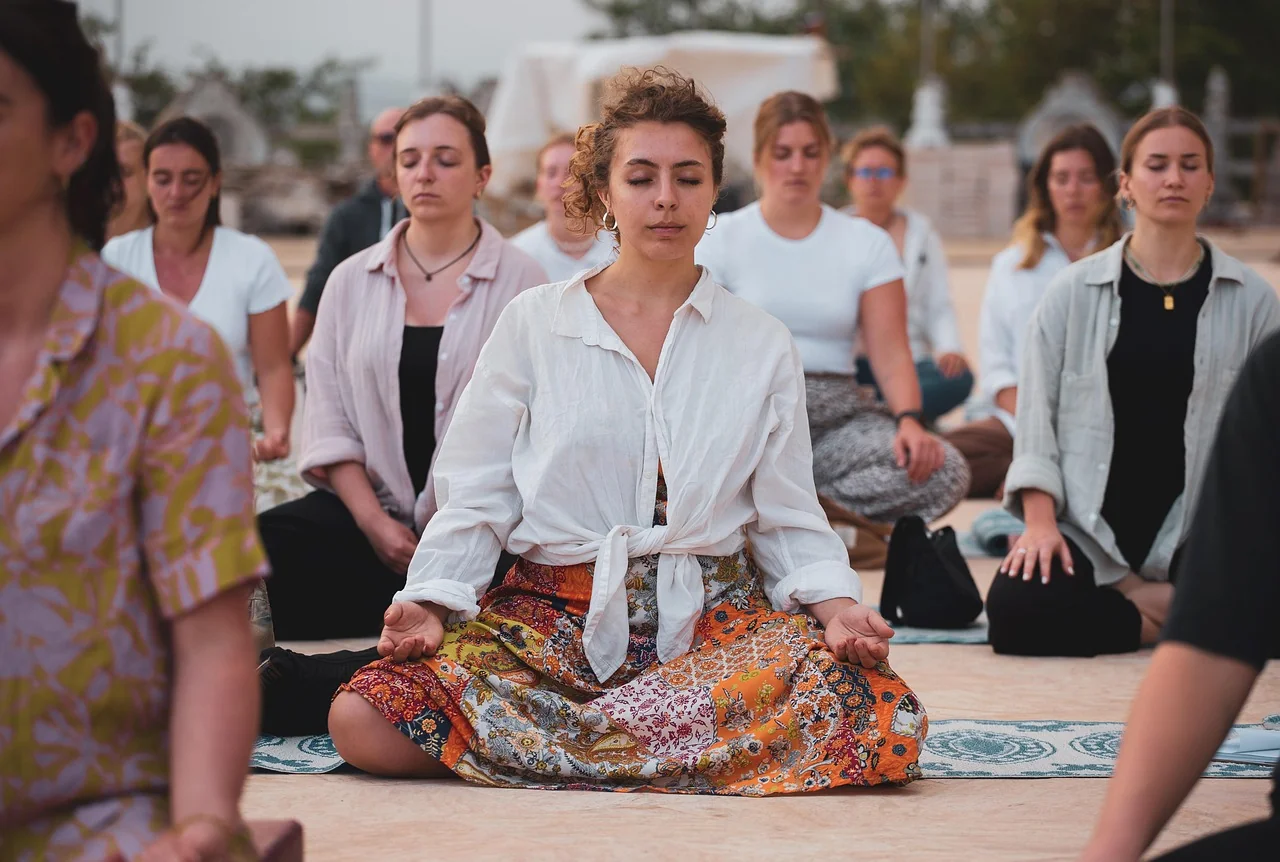You’ve heard it a million times: “You should meditate.” It’s touted as a cure-all for stress, a boost for focus, and a path to inner peace. But when you actually try to sit down and do it, you’re met with a racing mind, a fidgety body, and the sinking feeling that you’re doing it wrong. If your silent plea is, “Just tell me how to actually meditate,” you’ve come to the right place.
This isn’t about emptying your mind or achieving enlightenment overnight. True meditation is a practical skill—a training ground for your attention. It’s about learning to observe the chaos of your thoughts without getting tangled in it. This no-fluff guide cuts through the confusion and gives you a clear, step-by-step path to build a practice that fits your real life. Let’s drop the pressure and finally learn how to meditate, for real.
What is Meditation (And What It Isn't)
Meditation is not about stopping your thoughts. Your brain is designed to think; trying to halt that process is like trying to stop your heart from beating. The moment you sit down, your mind will likely kick into overdrive, rehashing a conversation from yesterday, planning your dinner, or wondering if you remembered to lock the front door. This is completely normal.
So, if it's not thought-stopping, what is it?
Think of meditation as a workout for your awareness. It’s the practice of intentionally focusing your attention on an anchor—like your breath, a word, or a physical sensation—and gently guiding it back when it inevitably wanders. The "magic" isn't in having a blank mind; it's in the moment you realize your mind has wandered and you choose, without judgment, to return to your anchor. That single act of noticing and returning is the repetition that builds your mental muscle. It’s learning to sit in the driver's seat of your attention, rather than being a passive passenger on a chaotic thought-train.
Why a Consistent Practice is a Game-Changer
Building a short, daily meditation practice delivers tangible benefits that ripple through every part of your life. This isn't just spiritual talk; it's backed by neuroscience. The key is consistency, not duration. Five minutes every day is far more powerful than an hour once a month.
Stress Reduction: Meditation trains your nervous system to downshift from the frantic "fight-or-flight" state to the calmer "rest-and-digest" state. By regularly practicing observing your stress without immediately reacting, you create a critical pause. This allows you to respond to challenges thoughtfully instead of reflexively snapping. For those dealing with intense emotions, exploring how to meditate for depression and anxiety can offer more targeted relief.
Improved Focus: In a world of constant notifications, our attention is fragmented. Meditation is the ultimate focus training exercise. Each time you bring your wandering mind back to your breath, you are strengthening your brain's neural networks for concentration. This makes it easier to stay on task at work, listen intently in conversations, and read a book without losing your place.
Better Emotional Regulation: Meditation helps you create space between a triggering event and your response. Instead of being hijacked by a wave of anger or anxiety, you learn to recognize the physical sensation of the emotion (the tight chest, the hot face) and watch it rise and fall without being completely consumed by it. You are the sky, not the storm passing through.
Enhanced Self-Awareness: A regular practice turns the spotlight inward. You begin to notice your habitual thought patterns—the inner critic, the worrier, the storyteller. This awareness is the first and most crucial step toward changing unhelpful patterns and cultivating more compassionate ones, turning your practice into a powerful guide to self-discovery.
Your First Meditation: A Simple 5-Minute Practice
Ready to try it? Here is a straightforward, step-by-step guide for your first session. Read through it once, then set a timer and give it a go.
Find Your Seat: Sit on a chair with your feet flat on the floor, or cross-legged on a cushion on the floor. The goal is to have a posture that is both alert and relaxed—an upright spine (don't stiffly strain, just sit tall) and relaxed shoulders. Rest your hands comfortably on your knees or in your lap.
Set a Timer: For your first time, set a timer for just 5 minutes. This removes the mental burden of checking the clock and makes the commitment feel manageable.
Notice Your Body: Gently close your eyes or lower your gaze. Bring your attention to the physical sensations of your body. Feel the weight of your body on the seat, your feet on the floor, and your hands resting. Take one or two deep breaths to settle in.
Tune into Your Breath: Now, bring your attention to your natural breath. You don't need to force it to be deeper or slower. Simply notice the physical sensation of the air moving in and out of your nostrils, or the rise and fall of your chest or abdomen. This is your anchor.
Gently Guide Your Attention: Within a minute or two, your mind will wander. You’ll start thinking about your to-do list, a song might get stuck in your head, or you'll plan your weekend. This is not a failure. This is the practice. The moment you realize your mind has drifted, gently and kindly acknowledge it by silently saying, "thinking," or "wandering." Then, gently guide your attention back to the sensation of your breath. You might do this five times or fifty times in five minutes. It doesn't matter. Each return is a rep.
Close with Kindness: When your timer chimes, don't jump up immediately. Slowly bring your awareness back to the room. Notice any sounds. Gently wiggle your fingers and toes. Slowly open your eyes. Take a final moment to acknowledge yourself for showing up.
4 Common Meditation Techniques to Explore
Once you're comfortable with the basic breath-focused practice, you can explore other styles to see what resonates with you.
Mindfulness Meditation
This is the technique described above and is the foundation for most modern practices. The goal is to be openly aware of whatever is happening in the present moment without judgment. While the breath is the most common anchor, you can also choose to anchor yourself with sounds or bodily sensations.
Loving-Kindness Meditation
Also known as Metta, this practice is aimed at cultivating compassion and unconditional kindness for yourself and others. You silently repeat a series of phrases, directing them first to yourself, then to a loved one, a neutral person, a difficult person, and finally to all beings. A common phrase set is: "May I be happy. May I be healthy. May I be safe. May I live with ease."
Body Scan Meditation
This technique is excellent for releasing physical tension and connecting with your body. You systematically move your attention through different parts of your body, from the tips of your toes to the top of your head. For each area, you simply notice the sensations there—warmth, coolness, tingling, pressure, or even numbness—without trying to change anything.
Walking Meditation
If sitting still makes you too restless, walking meditation is a perfect alternative. Find a quiet path about 10-20 paces long. Walk slowly and deliberately, focusing all your attention on the physical experience of walking. Feel the lift of your foot, the movement through space, and the placement of your foot back on the ground. When your mind wanders, gently bring it back to the sensations in your feet and legs.
Navigating Common Roadblocks: You're Not Doing It Wrong
Every meditator, from beginner to master, encounters challenges. The key is to not let them derail your practice.
"My mind won't stop wandering!" This is the most universal experience. Remember, the goal is not to prevent the wandering, but to become better at noticing it. The act of noticing you're distracted and choosing to return to your anchor is the core exercise. It's like a bicep curl for your brain—the value is in the movement, not in holding the weight still.
"I get too restless or bored." Restlessness and boredom are just other forms of mental activity. Instead of fighting them, get curious. What does restlessness feel like in your body? Where is the sensation of boredom located? Observe these feelings with the same gentle attention you give to your breath. Often, simply naming the feeling—"ah, restlessness is here"—robs it of its power.
"I don't have time to meditate." This is where the "consistent over long" rule applies. Can you find five minutes? That's enough. Link it to an existing habit to make it stick, like right after you brush your teeth in the morning or during your first coffee break. The investment of five minutes will pay you back in greater focus and calm for the rest of your day, effectively giving you more time. If you're looking for the most efficient path, our guide on the best way to learn how to meditate can help you optimize your practice.
"I fall asleep." If you're falling asleep, you might genuinely need the rest, or you might be meditating in a posture that's too relaxed. Try sitting more upright in a chair with your back unsupported, or meditate with your eyes slightly open with a soft gaze downward. A little bit of physical tension in your core can help maintain alertness.
Embarking on a meditation practice is not about achieving a state of perfect emptiness, but about learning to gently return to the present moment, again and again. The true essence lies not in the duration of your session but in the consistency of your effort. Remember that the breath is your ever-present anchor, your body is a map of sensations, and wandering thoughts are not failures but opportunities to practice kindness with yourself. The goal is not to stop thinking, but to change your relationship with your thoughts. By starting small with just a few minutes each day, you build a sustainable habit that can weather the storms of a busy mind and a busy life. This journey of self-discovery unfolds one breath at a time, cultivating a profound sense of calm and clarity that gradually infuses your entire day. Your path to a more centered and mindful life begins not tomorrow, but with the very next breath you take.

